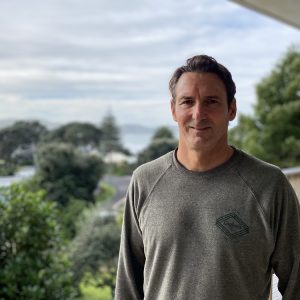At Maz Quinn’s favourite surf break at Mahia the waves roar over a shallow rock reef making them fast, clean and steep.
“That’s what makes it so good and hollow and gives you those great barrels,” says the legendary New Zealand surfer. “It’s a really world-class break, but it’s one that can have consequences.”
Over the years he’d seen surfers suffer injuries on that dangerous wave from a broken leg to multiple dislocated shoulders.
“I guess it was just my turn.”
For him, that turn came in late June when Maz had gone for an early-afternoon surf at Mahia, accompanied by partner Ngahuia and their then-10-week-old son, Freddy, out for his first day trip.
The spot was really working with good-sized, clean swell but after taking off on the first wave of a big set, he didn’t make the drop and was driven down to the rocky bottom, his torso and lower back taking the brunt of the initial impact.
“At first the wind was knocked out of me but by the time I popped up I was screaming in agony,” he says. “I could feel my feet and legs so wasn’t scared I’d broken my spine, but that pain was immediate and really, really intense.”
Hidden from other surfers by the waves, and by those on land by the dunes, Maz was pushed to shore by what he says was probably the best wave of the entire set.
“So I had to grovel along the sand and it took about 20 minutes until I was spotted,” he says. “It had to be the longest 20 minutes of my life.”
From there, things moved quickly. After checking his condition Maz’s rescuer alerted Ngahuia and in a stroke of luck located an off-duty paramedic in the nearby carpark.
The paramedic was able to notify her St John ambulance station at Mahia and they arrived in minutes, then the Trust Tairāwhiti Eastland Rescue Helicopter was called.
“I kind of relaxed after that. I’d been given meds that were kicking in and I was so relieved to hear the helicopter was on its way,” he says.
“And Ngahuia was amazing, really calm throughout the whole thing.”
Gisborne Hospital was over 100 kilometres away – up to 90 minutes of driving on a cyclone-damaged highway – so the prospect of travelling by road did not appeal, he says.
Instead, once he’d been assessed and treated by the on-board critical care flight paramedic, it took just 18 minutes to fly him to the emergency department door.
There he was x-rayed and diagnosed with breaks in four ribs and four spinal processes (the bones at the base of the spine connecting the ligaments), and was first admitted to the Intensive Care Unit before spending another six days on the ward.
Trust Tairāwhiti Eastland Rescue Helicopter critical care flight paramedic, Gareth McDougall, said as well as managing Maz’s pain it was important to monitor for signs of internal bleeding.
“But the Mahia St John team had done a great job in keeping him warm so he didn’t get hypothermic; establishing IV access for pain relief; and strapping him to a spinal board to keep him secure,” he says.
“That sort of attention means we can get in the air faster, which is always better for our patient.”
Despite the serious nature of his injuries, Maz reckons he was lucky: lucky to have never lost consciousness; lucky to have been spotted; lucky to have immediate medical attention; lucky initial fears he’d broken his pelvis did not come to pass; and lucky the helicopter crew could give him a fast flight to Gisborne Hospital.
At the age of 46 and a with weekly-routine of cross-fit training and “lots and lots” of surfing, Maz reckons he’d never been so fit in his life (and for those reasons had been named in NZ Surf Journal’s list of the country’s top 10 surfers of 2023).
“The doctors believe that fitness is probably what saved me,” he says. “Surfers naturally have a pretty strong band of muscle across their backs and they say that took a lot of the impact.”
Ten days after the accident – three days after being discharged from hospital – Maz still had very limited mobility and a lot of pain, but was stoked to be back at his Wainui Beach home.
After 35 years of surfing, his latest injuries far exceed the torn meniscus (knee cartilage) and multiple stitches he’s suffered during a career that has taken him around the world.
And though frustrated at the amount of time he needed to spend out of the water, he sure wasn’t going to push it.
“As it is now I can’t even bend to pick Freddy up so I’m not a lot of help there,” he says.
“I can start physio in a couple of weeks but there’s still weeks of healing time, and at least another six weeks before the pain goes.
“I’ll definitely be frothing to get back out there but don’t want to mess things up, so will do whatever is needed to get back to 100 percent.”
In the meantime, Maz was happy to be home and – almost – in one piece.
“I was so grateful to get that immediate help from the paramedic, and to learn that the rescue helicopter was on the way,” he says.
“It’s such a critical service to have in our region and now I have first-hand experience of that.”
HEALING AT HOME: Though he had a long recovery in front of him, surfer Maz Quinn was grateful to have received quick-fire medical care after being injured in the waves at Mahia.
